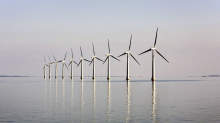Germany plans massive wind power grid
 Germany’s power-transmission companies have tabled plans to build four electricity Autobahns to link wind turbines off the north coast with manufacturing centres in the south - a boost for Angela Merkel after criticism from industry that Berlin has done little since announcing an accelerated nuclear phase-out a year ago.
Germany’s power-transmission companies have tabled plans to build four electricity Autobahns to link wind turbines off the north coast with manufacturing centres in the south - a boost for Angela Merkel after criticism from industry that Berlin has done little since announcing an accelerated nuclear phase-out a year ago.Tennet, Amprion, 50 Hertz and Transnet BW said that building 3,800km high-voltage electricity lines - at a cost of around €20-billion - over the next decade was possible if politicians and public rallied behind the so-called energy transformation.
Martin Fuchs, chief executive of Tennet TSO, the largest of the four companies, said he expected the lines to “provide the solid bedrock upon which the energy transformation can take place”, although he said this still required “a jolt” to pass through a society which in recent years has proved averse to network construction.
In a first blueprint for the government, the companies proposed 2,100km of direct-current power lines - similar to those used for undersea links like that between the U.K. to the European continent - to connect the North Sea and the Baltic coasts to the south.
On top of that, 1,700km of traditional alternating-current lines would have to be built, they said. These would complement 1,400km of this type of line already planned or being built - at a cost of €7-billion - under the government’s decade-old network plan.
Since Ms. Merkel closed eight of the country’s 17 nuclear reactors last summer and brought forward the phase-out of the energy source to 2022 from 2036, her biggest headache has proved the stability of the electricity network, which was designed to pipe nuclear electricity from south to north, not renewable electricity from the coast.
Europe’s largest economy came close to triggering blackouts at home and in neighbouring countries in February, when the instability that resulted from this change of flow was compounded by large electricity exports to France, and some gas-fired plants in southern Germany experienced difficulties in getting hold of fuel.
To fix this problem, Ms. Merkel has for a year been talking about the need to build gas-fired “reserve power plants” in southern Germany, and new transmission lines. Renewable energy sources are meant to generate 35 per cent of the country’s electricity by 2022, with 10,000MW of offshore wind farms providing the lion’s share.
Generous subsidies have led to a boom in solar power. Last weekend, German solar power plants produced a world record 22,000MW of electricity - although the government wants to cap solar expansion because it saps subsidies for other renewable sources.
With Germany’s last nine nuclear plants due to start closing in 2015, Klaus Kleinekorte, chief executive of Amprion, said it was “high time to start hurrying up” so that all four long-distance lines could enter service between 2017 and 2020.
“We need to see a closing of ranks with politics to make sure the network expansion works,” he said. In the past, separate planning procedures in Germany’s 16 states meant that power lines took 11 years to plan and build. The network operators are now relying on new national government powers to halve this time period.
You can return to the main Market News page, or press the Back button on your browser.

